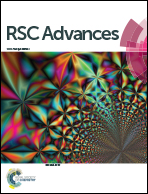Transforming linoleic acid into a nanoemulsion for enhanced activity against methicillin susceptible and resistant Staphylococcus aureus
Abstract
The activity of antibacterial agents can be enhanced by transforming them into the nano form. The aim of this study was therefore to enhance the antibacterial activity of linoleic acid (LA) against Staphylococcus aureus and methicillin-resistant S. aureus (MRSA) by formulating it as a nanoemulsion (NE). The mean globule diameter, polydispersity index and zeta potential of the optimized LA NE containing benzalkonium chloride (BAC) as a stabilizer were 75.14 ± 3 nm, 0.145 ± 0.01 and 45.7 ± 1.27 mV respectively. The turbidity absorbance, conductivity and viscosity were 1.773 ± 0.69, 0.0508 ± 0.006 mS cm−1 and 92.74 ± 2.17 mPas respectively, and the formulation was stable at 4 °C for 3 months. The LA NE was non-toxic and exhibited a 205-fold greater increase in the antibacterial activity than plain LA against S. aureus and MRSA. The fractional inhibitory concentration values indicated that the combination of LA and BAC had a synergistic effect. The molecular modeling studies revealed better stability of the LA–BAC system than LA with other surfactants. Bacterial protein degradation and cell morphology studies confirmed that the antibacterial activity of LA NE was due to cell membrane damage. These findings suggest that the developed LA NE could be a promising non-antibiotic drug containing antibacterial nano delivery system.


 Please wait while we load your content...
Please wait while we load your content...